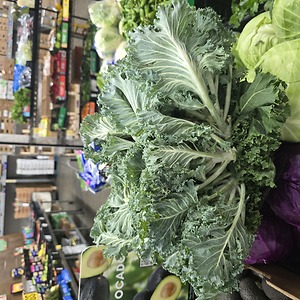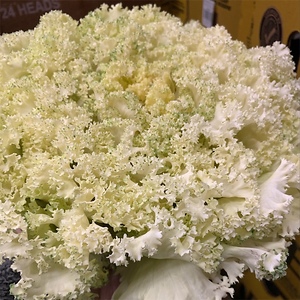


White Kale
Estimated Inventory, 24 ct : 2.37
This item was last sold on : 07/26/25
Description/Taste
White kale varies in appearance, depending on the variety, and generally forms low-growing, compact, dense rosettes. The rosettes are tightly layered with overlapping leaves, which are broad, pliable, deeply serrated, frilled, or ruffled. White kale appears in variegated shades of dark green, light green, ivory, and white. It is common for varieties to be green on the outside of the rosette and develop white hues in the interior portions during cold weather. In warmer weather, the rosettes may remain entirely green. One distinct trait of White kale varieties is their white veins and stems. White kale leaves have a tough, crisp, and chewy consistency, depending on the rosette’s maturity. Younger leaves will be more tender than older greens. Mature leaves are chewier, and the stems are thick and fibrous. When cooked, the leaves develop a softer consistency. White kale varies in flavor and aroma, depending on the variety. Some types may release an earthy, vegetal, cabbage-like scent, while others will be mild. White kale ranges in flavor, with mild, neutral, sweet, nutty, and vegetal notes to bitter, earthy, and grassy nuances.
Seasons/Availability
White kale is available year-round, with a peak season in the winter.
Current Facts
White kale, botanically classified as Brassica oleracea, is a general category encompassing several varieties belonging to the Brassicaceae family. The name White kale is used to describe cultivars that exhibit white veins and stems, sometimes referred to as ribs, and typically have green leaves. Several types of kale are encompassed under this broad term, including ornamental varieties and white Russian kale. The most common cultivars seen in commercial markets are ornamental or flowering types, mainly Kamome™, Nagoya, Condor White, Yokohama, Osaka, Peacock, Pigeon, and the Tokyo Series. White kale represents a specialty grouping of varieties that are more challenging to find in markets and are not commercially produced on a broad scale. The cultivars are primarily grown in home gardens as a decorative addition or planted in small quantities through select growers as a seasonal fresh market culinary ingredient. White kale is favored for its aesthetically pleasing appearance, cold hardiness, and low maintenance. Each variety will have a separate texture and flavor. In fresh markets, White kale is sought by chefs and home cooks in its baby stage for raw preparations and in its mature stage for savory cooked culinary dishes.
Nutritional Value
White kale has not been extensively studied for its nutritional value, and each variety will have its own levels of vitamins and minerals. Kale, in general, is a source of fiber to stimulate and aid the digestive tract and magnesium to help the body control daily nerve functions. Kale also provides calcium and phosphorus to support bone and teeth health, iron to develop the protein hemoglobin for oxygen transport through the bloodstream, and vitamins A, C, E, and K. Vitamin A maintains healthy organs, while vitamin C strengthens the immune system. Vitamin E guards the cells against free radical damage, and vitamin K aids the body in faster wound healing.
Applications
White kale varies in flavor and texture depending on the specific variety and can be used at various maturity stages for culinary preparations. Young greens are favored for their tender nature and commonly tossed into salads. Young kale leaves can also be layered into sandwiches, added to grain bowls, or blended into smoothies. Some White kale varieties may be more bitter than others. Stronger flavored kale greens should be boiled or blanched to help reduce their bitter taste. White kale is often simmered into soups and stews or braised, serving as a simple side. Mature greens are baked into crisp chips, sautéed, fried, or steamed to serve with savory main dishes. Try adding kale leaves to dips and spreads. They can also be added to stir-fries. Beyond cooking, some White kale varieties are used as ornamental decorations on culinary plates or as a base layer for their visual texture and coloring. White kale pairs well with nuts, including peanuts, walnuts, and almonds, aromatics such as garlic, shallots, ginger, and onions, and herbs like oregano, thyme, and parsley. Whole, unwashed kale should be stored in a sealed container in the fridge, where it will keep for 3 to 5 days.
Ethnic/Cultural Info
In Japan, White kale varieties that are a part of the ornamental or flowering kale group are nicknamed leaf peonies and chrysanthemums. The frilly, contrasting green and white varieties were given these nicknames for their similarity in appearance to white flowers and are valued as a decorative addition to celebratory arrangements. White kale is popularly incorporated with red kale in kadomatsu, a type of New Year decoration. Kadomatsu is an arrangement of various plants that symbolize a resting place for the Shinto deity Toshigami-sama. Legend has it that the deity visits homes to bring happiness and good luck on New Year’s Day. The deity must be invited before it enters a home, and kadomatsu is the visual invitation traditionally placed at entrances to houses and businesses. Early kadomatsu arrangements appeared in historical texts connected to the late Heian period, and the name kadomatsu roughly translates to “pine gate.” Pine trees were historically used for the arrangements, and later throughout history, additional plants were added like bamboo, plum flowers, and ornamental kale. Red and white kale plants are said to symbolize good fortune as their dense, layered rosettes embody layers of fortune and luck. The coloring of the plants is also auspicious, and the low-growing rosettes are planted at the base of the kadomatsu as filler. Kadomatsu arrangements are typically created and placed outside sometime after December 26th and must be left at the entrances until January 7th or 15th, depending on the region’s specific New Year’s beliefs.
Geography/History
White kale is a descendant of wild types of Brassica oleracea native to the Mediterranean, Asia Minor, and the Middle East. The Greeks and Romans domesticated early forms of kale, and in the 4th century, various types were introduced to China through trade. Kale was quickly established in China as a culinary and medicinal ingredient, and the plants eventually made their way to Japan, where they were bred for their colorful, ornamental foliage. These varieties of kale later became known as ornamental kale. Most varieties categorized under the general White kale name are ornamental or flowering kale. While select ornamental kale varieties were being bred in Asia, other kale cultivars spread throughout Europe and were favored for their cold tolerance. Over time, kale, including types of White kale, expanded in cultivation and spread worldwide. Today, White kale is grown worldwide in commercial and home gardens, and many varieties are collectively sold under this name. White kale can be found at farmers markets, select retailers, and directly through growers.
Featured Restaurants
Restaurants currently purchasing this product as an ingredient for their menu.
| Maderas Golf Club | Poway CA | 858-451-8100 |
| San Diego Yacht Club | San Diego CA | 619-758-6334 |
| Happy Medium SD | San Diego CA | 509-869-2279 |
| Margaritaville Hotel SD (Kitchen) | San Diego CA | 619-819-9500 |
| Vertex - Merryfield Row | San Diego CA | 619-405-8950 |
| Terra Restaurant | San Diego CA | 619-293-7088 |
Podcast









